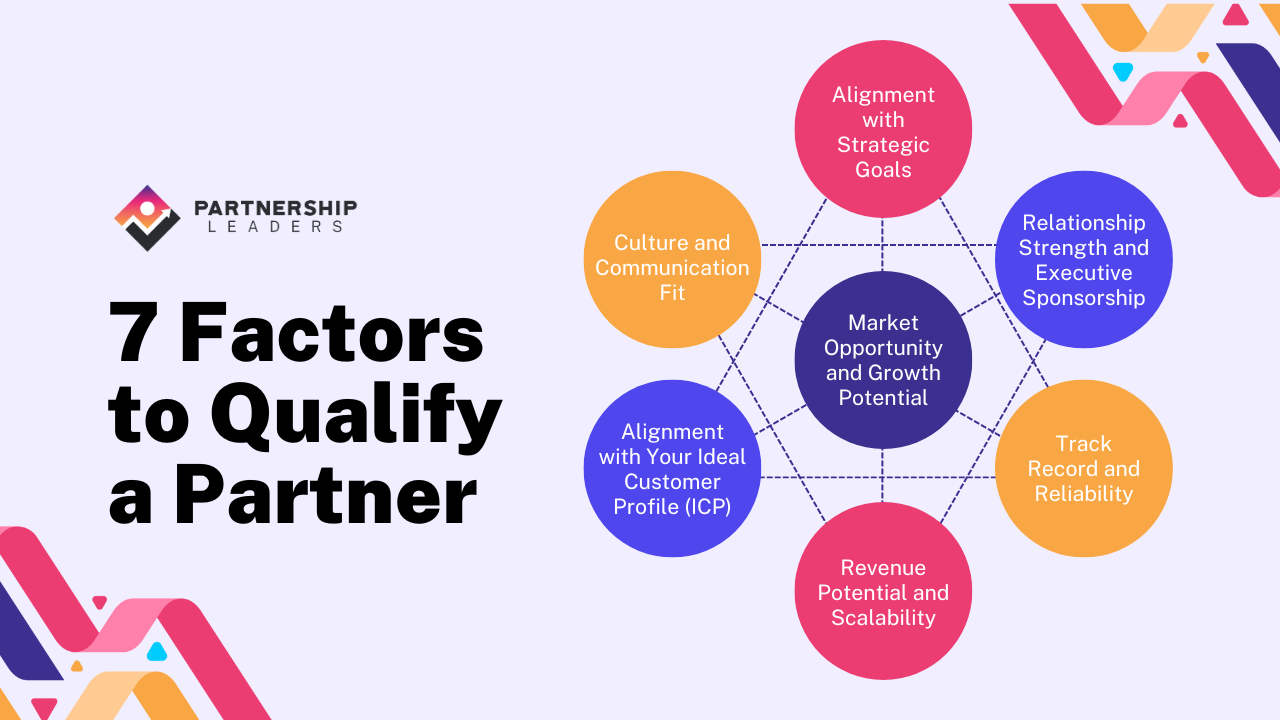This blog is part of the SCOPE: Partner Qualification Blog Series. All series content is powered by insights from our community experts.
The SCOPE Framework is designed to help you identify and prioritize high value partnerships with ease. SCOPE stands for Scale, Champion, Objectives, Proposition, and Executive Stakeholder — each a critical factor in building successful, scalable partnerships. In this member-only course, you’ll learn how to apply the framework to assess partner potential, align strategic goals, and drive revenue growth.

Check out the SCOPE Framework today and start building smarter, more impactful partnerships!
Choosing the right partner is like building a puzzle – every piece has to fit just right, or it all falls apart. In this first blog of our Partner Qualification series, we’ll explore the essential pieces you need to evaluate before locking in an alliance, and improving partner relationship management efforts.
These tips will help you avoid wasted resources and focus on partners who truly fit into your bigger picture. Ready to find the right piece? Let’s start!
1. Market Opportunity and Growth Potential
You need to look beyond what a partner offers right now and think about where they’re headed.
When assessing a partner’s market opportunity and growth potential, you’re tapping into the Scale component of the SCOPE framework. Scale is all about evaluating whether the partner has the resources, capacity, and market reach to justify a long-term partnership.
A partner with a small market presence might not be able to scale with your company as you grow. Conversely, someone in a growing market could unlock new opportunities for you both.
Chris Lavoie emphasizes evaluating the total addressable market (TAM) and scalability.
A partner might have a niche audience, but if that market is expanding, they’re worth a deeper look. Market growth potential signals long-term success, so it’s essential to understand how much room they have to grow and how they plan to do it.
The bigger their market potential, the better your chances of success. This foresight into a partner’s scalability is crucial for partner relationship management.
2. Alignment with Strategic Goals
This factor ties directly into the Objectives component of the SCOPE framework. Aligning with a partner’s strategic goals is essential because, no matter how much growth potential they have, the partnership will struggle if your objectives don’t complement theirs.
If you’re headed in opposite directions, no amount of growth will help your partner relationship management efforts.
“When objectives are not aligned, there was no reason to prioritize a partnership or put any effort behind co-marketing/co-selling with them.” – Steve Hellin
This is why the SCOPE framework emphasizes a clear understanding of mutual objectives from the start. Defining shared goals – whether it’s market expansion, product development, or revenue growth – ensures both sides are working toward common outcomes.
Sonia Marie Groff adds that aligning your partner’s profile with your company’s Ideal Partner Profile (IPP) refines your partner relationship management strategy.
Consider these questions when evaluating this alignment:
- Do their product or service offerings enhance yours?
- Are their long-term goals compatible with your vision?
- Is there a shared target audience or Ideal Customer Profile (ICP)?
“To truly be able to qualify partners, reprioritize partners, articulate joint-value propositions, etc we’ve found it helpful to revisit and clarify our IPP definition.” – Sonia Marie Goff
But don’t stop there – evaluate how well your teams will work together. Sonia also recommends using scorecards to assess strategic fit. Here’s what to consider:
- Do they have a champion or executive sponsor invested in the partnership?
- How strong is the existing relationship between your teams?
- Is there mutual trust and transparency?
3. Relationship Strength and Executive Sponsorship
Building strong relationships and securing executive sponsorship directly connect to two key elements of the SCOPE framework: Champion and Executive Stakeholder.
A Champion is your internal advocate within the partner’s organization—someone who supports your solution and can influence decision-makers. Chris Lavoie points out that a strong relationship with a champion is critical for long-term success. Even the best strategic alignment may falter without a champion pushing the partnership forward.
Bertus Van Overmeiren emphasizes the importance of executive sponsorship in his company’s “Partner Heartbeat” framework.
If an Executive Stakeholder isn’t driving the partnership, it may lack the necessary internal backing to thrive. A dedicated sponsor can ensure that both teams stay engaged and aligned.
Trust between teams also plays a huge role in partner relationship management. Progress will stall if your teams don’t work well together or trust isn’t established early. Building that trust and finding champions within the partner’s organization can make all the difference.
4. Track Record and Reliability
Past performance matters.
A partner’s track record and reliability are tied to the Proposition component of the SCOPE framework. The Proposition is about understanding a partner’s unique value, and part of that value comes from their history of delivering results.
If they’ve consistently delivered on promises and met expectations, they’re more likely to be a dependable partner moving forward. Even partnerships that look great on paper can crumble if the partner doesn’t deliver as expected.
Look for partners with proven success stories, solid case studies, or references that demonstrate their ability to perform. A partner who has delivered reliable results in the past is less of a gamble and more of an asset to your business.
In the SCOPE framework, evaluating a partner’s Proposition means not only understanding their value-add but also verifying if they have the operational stability and track record to support their claims. This ensures you’re not just investing in potential but in proven reliability.
5. Revenue Potential and Scalability
Revenue potential and scalability fit squarely under the Scale component of the SCOPE framework.
It’s not just about having a good relationship or aligning on goals – your partner needs to deliver revenue. Early investments in high-revenue potential partnerships can pay off in the long run.
If the revenue upside isn’t there, the partnership may not be worthwhile.
Scalability is key.
As the SCOPE framework emphasizes, a partner needs to have the capacity to expand in terms of market reach, customer base, and internal resources. If they’re too small or lack growth plans, they could hold back your own business ambitions.
6. Alignment with Your Ideal Customer Profile (ICP)
If a partner is targeting a completely different audience than you, it’s likely to cause friction down the road. Matching buyer personas is crucial for driving value in a partnership. When you and your partner speak to the same audience, co-marketing and co-selling become far more effective.
The Objectives part of SCOPE ensures that both sides are working towards complementary customer outcomes, while the Proposition helps craft a joint value that speaks to this shared audience.
“Buyer persona is a huge one because if both technologies are not speaking with the same buyer persona, it could get tricky.” – Samantha Samuels
To ensure alignment, consider these factors:
- Shared target audience: Are both you and your partner targeting the same type of customer?
- Customer needs: Do their customers have needs that your product or service can fulfill?
- Buyer persona overlap: Are your sales teams interacting with the same decision-makers?
Confirming alignment with your ICP will maximize the chances of creating a successful, revenue-generating partnership. This streamlines messaging, sales efforts, and joint campaigns, making everything run more smoothly.
7. Culture and Communication Fit
While the Champion in the SCOPE framework is often thought of as an advocate within the partner’s organization, their ability to foster smooth communication and collaboration is crucial. A partnership thrives when both sides enjoy working together and communicate effectively.
“I like to monitor, get feedback, and make an assessment of how the teams are working with one another. Simply put – does the partner like working with my team and vice versa?” – Maurits Piper
Assessing culture fit means looking beyond surface-level interactions.
Do your teams collaborate smoothly in meetings? Are there open lines of communication between departments like marketing, sales, and customer success? If there’s tension or miscommunication early on, it will only get worse over time.
Good communication is the backbone of any partnership. If your teams trust and respect each other, they’re more likely to resolve issues quickly and work towards shared goals.
Conclusion
Choosing the right partner involves more than just looking at numbers. By focusing on market opportunity, strategic alignment, and relationship strength, you set the stage for a successful partnership. Remember these critical factors to avoid mismatches and build partnerships that drive value.
In the next post of our Partner Qualification series, we’ll dive into how to recognize and disqualify a bad-fit partner before it’s too late.
Join The 1850+ Leaders Transforming Partnerships
As a member of Partnership Leaders, you will:
- Build and learn with the top partner people at the best companies around the world.
- Increase your impact and accelerate your career with proven resources, tools, and best practices.
- Grow a network of peers, partners, and advisors with common objectives.




